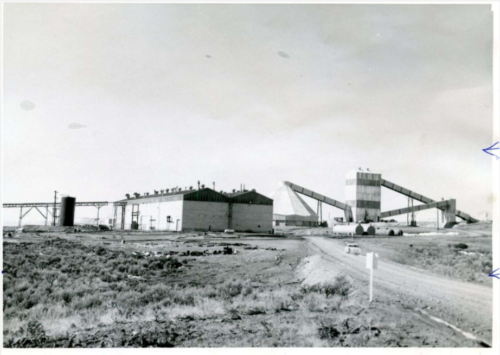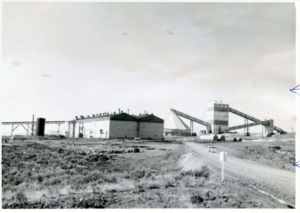
Industry News | CWP
History in Focus: The Atomic Age
April 12, 2021
April 12, 2021
CWP
Industry News
In November of 1953, a small Cessna 179 piloted by Russell Cutter, a geologist for Arrowhead Uranium Corporation, flew in low over the area just north of Lay and Mabyell. The readings from his on board portable Halross Scintillation Counter, a device used to measure radiation and the presence of uranium, confirmed Cutter’s hopes. The atomic age had arrived in Moffat County.

After the atomic bombings of Hiroshima and Nagasaki ended WWII, the Soviet Union detonated their first bomb in 1949. The ensuing arms race set off a scramble to discover and mine uranium, the crucial fissile material for nuclear weapons and energy. As demand skyrocketed, attention quickly focused on previously known deposits in our local Brown’s Park sandstone.
After Cutter’s flight, a group of stockholders of Arrowhead Uranium Corporation formed Trace Elements Corporation (TEC) and quickly purchased mining leases on a strip of public and private lands eight miles wide and four miles long in the area west of Sugar Loaf Mountain, just three miles northeast of Maybell, and slightly north of Highway 40 (Craig Empire Courier, 8/10/55).
Exploratory drilling was conducted to verify and chart the quantity and quality of the uranium outcroppings. In August of 1955, the Atomic Energy Commission (AEC) signed a five year agreement with Trace Elements to build a mill to extract uranium from 300 tons of ore per day (Craig Empire Courier, 8/17/55).
The plans for a local uranium mill touched off a rush by smaller independent mining operations to hunt down other local sources of uranium. A map of the region in the October 12, 1955 Craig Empire Courier highlighted Poison Buttes (northwest of Baggs), the Fish Creek Falls area east of Steamboat Springs, and an existing mine on Uranium Mountain on Thornburg Road 45 miles south of Craig. Several undefined and unnamed areas with claim filings were also represented by hazy undefined circles. A uranium boom was in the air!
On March 6, 1957, the Craig Empire Courier announced with a banner headline: “Ground Broken for $3,000,000 Maybell Uranium Mill.” In November of 1957, the mill opened and delivered its first load of concentrate to the AEC in December. Annual production reached its peak in 1963 when 355,041 tons of ore produced 720,384 lbs of U3O8, Triuranium oxide, otherwise known as “yellow cake.” These shipments were sent to Grand Junction and beyond for further refining into nuclear material. (Chenoweth, RMAGeologists, 1986).

In 1964, Union Carbide bought out Trace Elements and suddenly announced it would close the Maybell mill and fulfill its contract to the AEC through operations in Uravan, Colorado. The mill was abandoned and sat idle until a spike in uranium prices in the mid 1970’s. Heap leaching with sulphuric acid of the leftover tailings started in 1976 and lasted until the pits closed for good in 1981.
Under the Uranium Mill Tailings Radiation Control Act of 1978, plans were initiated to clean up the site. A 1990 Department of Energy Assessment cited concerns about the windblown area adjacent to the mines, contaminated soils, and water contamination from pond effluent leaking into Johnson Wash and continuing a mile into Lay Creek, including 200 tons of tailings that escaped into Johnson Wash in 1961. Elevated levels of heavy metals were also recorded in nearby groundwater.
Today, the tailings and demolished mill are safely ensconced in a 66 acre lined cell on the original mill site, according to a Department of Energy fact sheet. In total, the uranium mines in the Maybell area produced 5.3 million pounds of “yellow cake.”
It’s exciting and frightening to imagine a small portion of Moffat County was possibly part of a brilliant and destructive explosion over the vast Pacific Ocean during the early Cold War. Perhaps it’s even more frightening and foreboding how quickly our sagebrush desert became an important player in the atomic age.
Thanks to Dan Davidson, Director of the Museum of Northwest Colorado for access to the museum archives and Jennifer Maiolo and Hunter Seim of the BLM Little Snake Field Office for assistance in reviewing BLM archives regarding uranium mining in Moffat County. Special thanks to Megan Neton for her editorial assistance.
